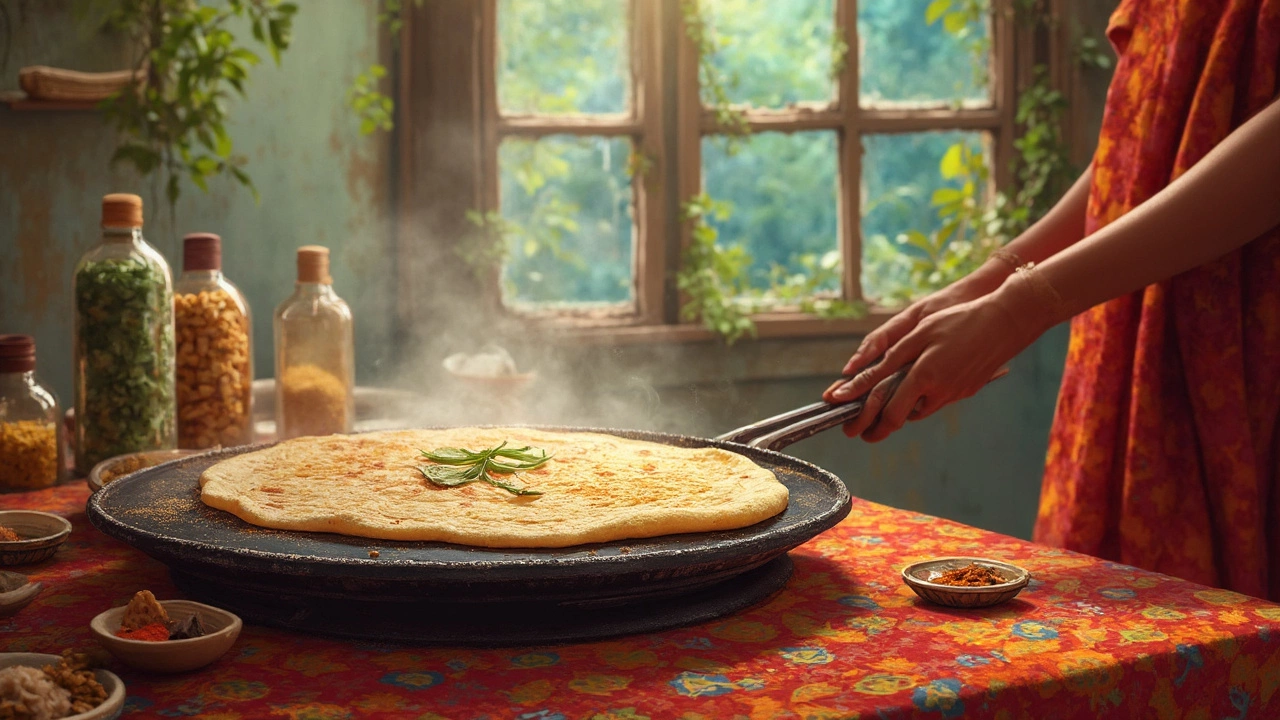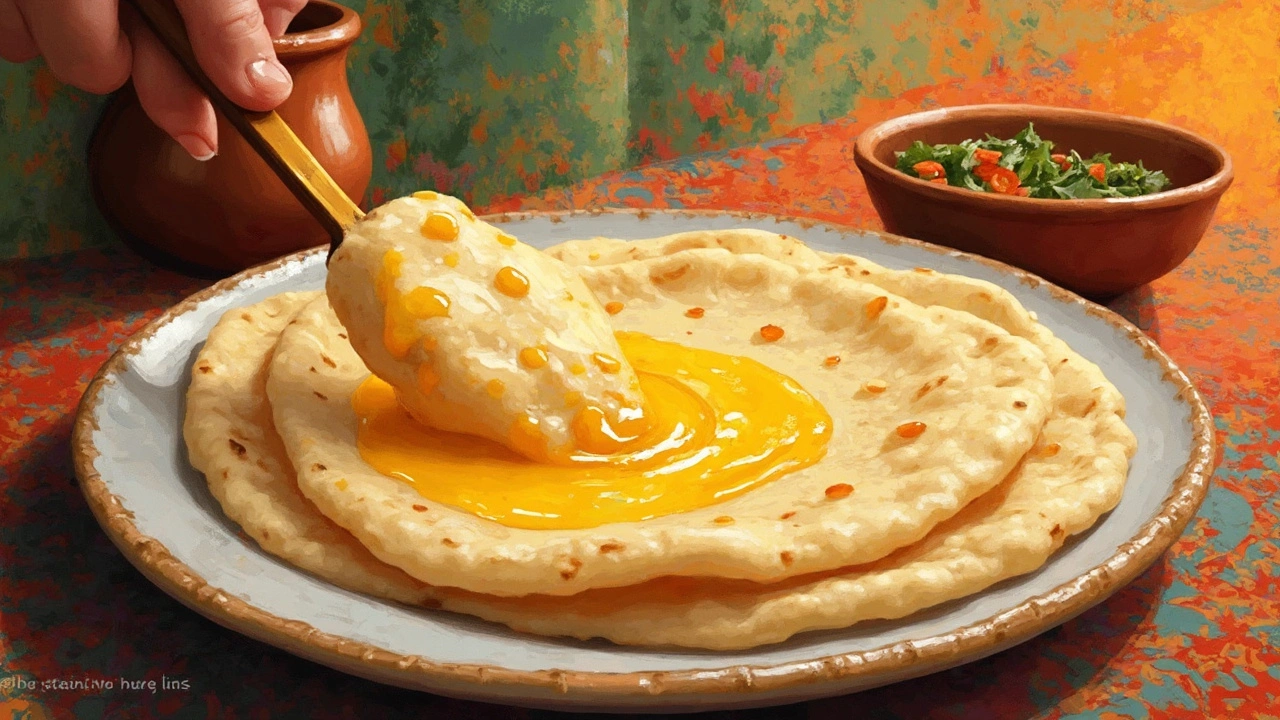Understanding Roti's Glycemic Index and Caloric Impact
 Feb, 24 2025
Feb, 24 2025
Roti is a daily staple for many, but have you ever wondered how it fits into your dietary plan? Let's break it down, starting with understanding how many calories are in a roti. A plain roti, made with whole wheat flour, contains approximately 70-80 calories. That might not sound like much, but it's important when you think about how these add up with all the other components of a meal.
When pairing roti with sabzi, you might be looking at an additional 50-100 calories, depending on the preparation. The combination is not just filling but also nutritious. The vegetables in sabzi provide essential vitamins and minerals, making it a wholesome meal.
Now, if you add a spoon of ghee to your roti, you'll increase the total calorie count considerably. Ghee can add around 30-40 calories with just a small amount. It’s delicious and adds flavor, but moderation is key if you're keeping an eye on the numbers.
- Roti Basics
- Caloric Breakdown
- Calories in Roti and Sabzi
- Calories in Roti with Ghee
- Understanding Glycemic Index
- Tips for a Balanced Diet
Roti Basics
Roti is not just a type of bread; it's a cornerstone of many meals. Made from whole wheat flour, it’s both nutritious and delicious. If you're wondering what makes it a popular choice, it's all about simplicity and nutrition.
What is Roti Made Of?
The primary ingredient in roti is whole wheat flour. Mixing this with water makes a soft dough, which is then rolled out into flat, circular shapes before cooking on a hot, flat pan known as a tawa. This basic process hasn’t changed over generations—part of its charm!
Nutritional Value
Whole wheat flour offers a good dose of fiber, keeping your digestive system happy. Beyond that, it contains important nutrients like iron and vitamin B. Because you're making it fresh, you know exactly what's going into your meal, avoiding the preservatives in some store-bought breads.
Why Roit is a Smart Choice?
If you’re counting calories, a single roti contains about 70-80 calories, making it a smart choice for balanced meals. Its glycemic index is relatively low, meaning it causes a slower, more sustained release of blood sugar—ideal if you're watching your sugar levels. Plus, you can pair it easily with protein-rich dals or loads of veggies for a complete meal.
Making the Perfect Roti: A Step-by-Step Guide
- Mix Ingredients: Combine whole wheat flour and water in a bowl, adding a pinch of salt if desired.
- Knead Dough: Knead until smooth and pliable. Cover and let it rest for about 15 minutes.
- Shape the Roti: Divide into small balls, roll out with a rolling pin on a floured surface to a thin circle.
- Cook: Place on a hot tawa, cook until bubbles appear, then flip. Once both sides have brown spots, you're done!
With these steps, you can easily integrate the humble roti into your diet, all while keeping it nutritionally beneficial. Remember, whether it's roti with sabzi or ghee, it allows a variety of healthy pairings.
Caloric Breakdown
Understanding the caloric content in a roti is essential if you're keeping tabs on your daily caloric intake. Let's dive into what makes up those calories and how you can manage them effectively. A typical roti, depending on its size and thickness, contains about 70-80 calories. This comes primarily from carbohydrates, making it an excellent energy source.
The Role of Ingredients
The basic ingredients in roti are whole wheat flour, water, and sometimes a pinch of salt. Whole wheat flour is the main contributory factor to its calorie count. For a standard roti, you can expect around 15 grams of carbohydrates and about 3 grams of protein.
Calories in Different Types of Roti
Roti variations, like those made with added butter or oil, naturally pack more calories. A roti with ghee can add an extra 30-40 calories, primarily from fats.
Factors Affecting Calorie Intake
- Serving Size: Thicker or larger rotis will obviously have more calories.
- Cooking Method: Using oil or ghee while cooking adds to the calorie content.
Keeping these factors in mind helps tailor your diet according to your nutritional goals.
Balancing Your Meal
Pairing roti with sabzi is an excellent way to balance your meal. Here's a simple formula: ensure your plate is half filled with vegetables, a quarter with rotis, and the remaining quarter with lean protein. This ensures you get a variety of nutrients in one meal.
Looking to cut back on calories? Opt for smaller-sized rotis or skip the ghee. Moderation remains key. By understanding the caloric content and making small adjustments, you can enjoy your meals without guilt!
Calories in Roti and Sabzi
Pairing roti with sabzi is more than just a delicious combo; it's a tradition ingrained in daily meals for countless households. But how many calories are packed into this meal?
On average, a serving of roti, as we know, contains about 70-80 calories. When we consider sabzi, the calorie content can range widely. Vegetables like spinach, cauliflower, or mixed vegetable curry could add around 50-100 calories to the meal, depending on preparation and portion size.
Factors Affecting Caloric Content
1. Cooking method: Simple steamed or stir-fried veggies have fewer calories than those cooked in rich gravies or with excessive oil.
2. Ingredients used: Potatoes and peas, for example, may increase calorie count compared to leafy greens. Pay attention to what goes into your sabzi.
Making a Balanced Meal
Having a balanced meal is essential. You might be asking: How can I enjoy roti and sabzi without worrying about consuming too many calories?
- Go for whole wheat roti over refined flour variants.
- Include a variety of colorful veggies in your sabzi for nutrients and fewer calories.
- Limit the use of oils or heavy cream in preparation. Opt for spices and herbs for flavor without added calories.
Remember, it’s about balance, not elimination. By making mindful choices, you can relish your traditional meals while keeping an eye on caloric intake.

Calories in Roti with Ghee
Adding ghee to your roti can transform a simple meal. While ghee enhances the flavor and makes it richer, it also significantly increases caloric intake. So how much are we talking about?
For just a teaspoon of ghee, about 5 grams, you add about 45 extra calories on top of the calories in 1 roti. So if one roti has 70-80 calories, a roti with ghee can total about 115-125 calories. Little choices, big impact!
Why Add Ghee?
- It adds essential fats to your diet, which can be great for energy.
- Ghee has fat-soluble vitamins like A, E, and K, beneficial for various bodily functions.
- The rich taste of ghee makes dishes feel more indulgent, even when they aren’t.
Keeps Balance in Check
While enjoying roti with ghee now and then is fine, it's about keeping things in moderation. Here's a simple plan:
- Consider using it in one meal a day if you're watching your calorie intake.
- Pair a ghee-glazed roti with a fresh salad or steamed veggies to make up for the added calories.
- Use cooking spray ghee for the flavor perk without the full calorie load.
Small changes can align your taste preferences with your diet goals, ensuring you don’t have to give up on flavors you love. So, enjoy your roti with ghee, but be mindful of how it fits into your daily nutritional intake!
Understanding Glycemic Index
The Glycemic Index (GI) is a tool that measures how quickly a food item raises blood sugar levels. Foods with a high GI can spike your blood sugar, while those with low GI increase it gradually. Understanding this can really help you make healthier dietary choices.
Where does roti stand? Whole wheat roti typically has a medium GI, making it a better option than white bread or other refined grains. That's why including roti in your meals can often be a healthier choice. But be careful with the portions and what you pair it with, like roti and sabzi, to maintain a balanced glycemic impact.
As nutritionist Dr. Neelam Singh states, "Choosing foods with a lower glycemic index can help you manage insulin levels and keep energy steady throughout the day."
Here's what you can do to ensure your roti consumption is on point:
- Stick to whole wheat roti: Avoid refined flour versions. The fiber in whole wheat helps in better digestion and lowers the GI.
- Watch the condiment: Adding condiments like ghee will increase the fat content and could alter the GI, so use them sparingly.
- Mind the pairing: Pair your roti with vegetables or protein for a balanced meal, which helps in slowing down carbohydrate absorption.
To visualize how roti compares to other foods, take a look at this simple table:
| Food Item | Glycemic Index |
|---|---|
| Roti | 45-55 |
| White Bread | 70+ |
| Brown Rice | 50-55 |
By incorporating these strategies, you can make your diet healthier without missing out on the benefits of traditional foods like roti.
Tips for a Balanced Diet
Eating a balanced diet doesn't mean you have to give up your favorite foods like roti. With the right approach, you can enjoy traditional meals while watching your health. Let's look at some practical tips to maintain balance.
Portion Control
It's easy to overlook, but keeping an eye on how much you eat is crucial. If you love roti, keep it to one or two per meal instead of overindulging. Pair it with a generous serving of veggies for a more nutritious and filling meal.
Smart Pairings
Your calories in 1 roti can be part of a balanced meal with the right accompaniments. Choose high-fiber veggies and proteins like lentils or chicken. This combo will keep you full longer and provide needed nutrients.
Cook Wisely
While ghee adds flavor, it also boosts calories. Consider using a brush to apply a minimal amount or skip it altogether if you're focusing on losing weight. Alternatively, try healthier oils like olive oil using the same method.
Stay Hydrated
Often, what feels like hunger is actually thirst. Drink a glass of water before eating; this helps control portions and keeps you hydrated. Thirst often mimics hunger, leading to unnecessary snacking.
Listen to Your Body
Your body knows what it needs. If you're hungry, eat; if you're satisfied, stop. It's that simple but often ignored. Listening to your body's signals can prevent overeating and promote healthy habits.
| Calories in Food Combinations | Approximate Calories |
|---|---|
| 1 Roti | 70-80 |
| 1 Roti with Sabzi | 120-180 |
| 1 Roti with Ghee | 100-120 |
By keeping these tips in mind, you can enjoy your meals and maintain a healthy lifestyle. Make smart choices with your roti nutrition, and you'll see the benefits in the long run.